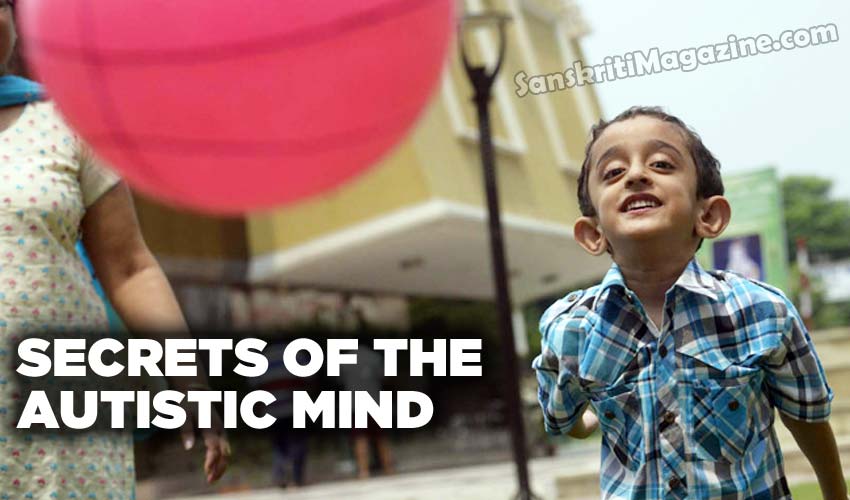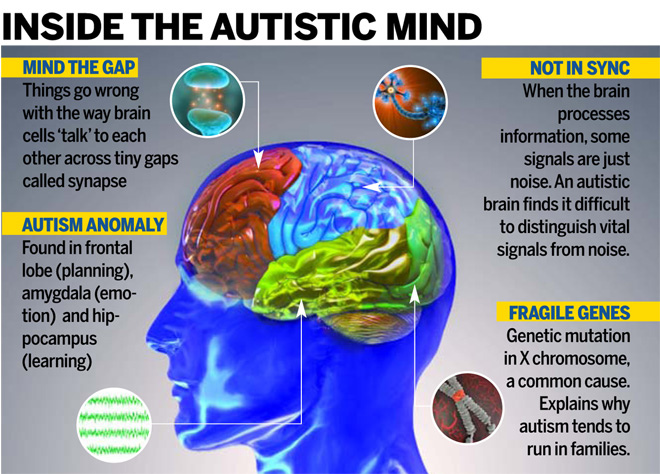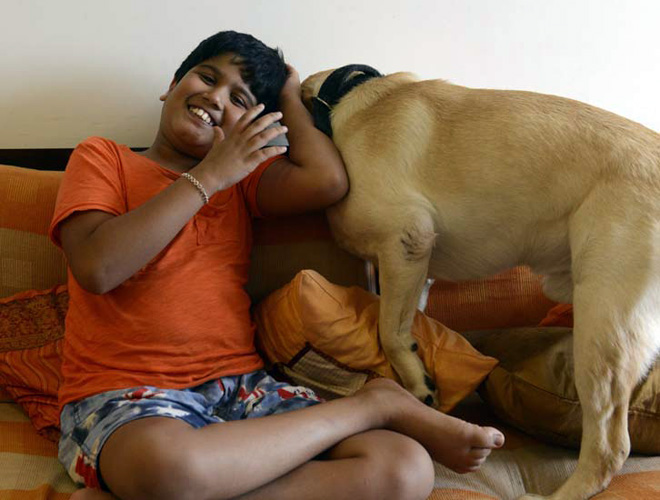Sumantra Chattarji is frying a bit of brain. Or so it seems. The neurobiologist at Bangalore’s National Council of Biological Sciences (NCBS) is passing current through a slice of brain kept alive artificially. One can hear the hiss and sizzle. But he is trying to listen in on a different ‘sound’: The electrical language of two brain cells ‘talking’ across an infinitesimally tiny gap, 25 billionths of a metre. As he steps up voltage, a jumble of spikes and dips drift across the screen. “The cells are talking too much,” he says. “A typical autistic brain.”
 For years, India did not find the number or extent of the disorder. Doctors routinely called it a Western syndrome, doubting its prevalence here. “It’s one of the most misdiagnosed disorders,” says Dr Vibha Krishnamurthy, founder of Mumbai-based Ummeed, a non-profit resource for autistic children. Diagnosis gets delayed as doctors treat it as mental retardation or schizophrenia or blame bad parenting. Shattering the myths is a survey that puts numbers in place for the first time in India.
For years, India did not find the number or extent of the disorder. Doctors routinely called it a Western syndrome, doubting its prevalence here. “It’s one of the most misdiagnosed disorders,” says Dr Vibha Krishnamurthy, founder of Mumbai-based Ummeed, a non-profit resource for autistic children. Diagnosis gets delayed as doctors treat it as mental retardation or schizophrenia or blame bad parenting. Shattering the myths is a survey that puts numbers in place for the first time in India.
Myth: Autism is not common yet in India
Reality: Highly prevalent and rising
More than 10 million children in India suffer from autism, shows the first-ever survey. “We found about 1 to 1.5 per cent autistic children between ages two and nine in India,” says Dr N.K. Arora, executive director of the International Clinical Epidemiology Network Trust (INCLEN), which led the study. That means a prevalence rate of one in 66. In the absence of national studies, the estimated rate for autism in India so far varied between an impressionistic 1 in 500 and 1 in 150. The survey was conducted on 4,000 households in Andhra Pradesh, Odisha, Himachal Pradesh, Haryana and Goa in collaboration with aiims, Thiruvananthapuram Medical College and universities of Stanford and Pennsylvania, US.
“Autism warrants immediate attention,” says Dr Arora, a paediatrician who has worked in AIIMS. INCLEN has also developed an instrument to diagnose the severity of autism in the Indian context. Currently, the Autism Diagnostic Observation Schedule, designed in the West, is being used in India. “The numbers are alarming and calls for policy-making and interventions to bring these children into mainstream society,” says Dr Arora.
Myth: No one knows what causes it
Reality: The problem lies in the way brain cells connect
“Remember the famous London tube warning, ‘Mind the Gap’? The mind has many gaps. The ultimate challenge is to find out what exactly happens here,” says Chattarji. The electrophysiology lab at NCBS demands silence: No watches, no mobiles, no movements. The lab is chock-a-block with wires, pipes, test tubes, a digital screen blinking here, a microscope zooming there. Researchers prod brain slices to record electrical activity. That data will allow Chattarji to trace the architecture of autistic brains. As the computer screens show, billions of neurons ‘talk’ to each other across trillions of gaps (called synapses)-at one-tenths of the time it takes to blink an eye. That communication determines a person’s mental traits: Why we write poetry or solve complex math. “In autism, the wiring goes wrong,” says Chattarji.
On a typical day, Delhi twins, six-year-olds Nikki and Kush, don’t disturb anyone. They sing “Chugga-chugga, chug, chug” as they play with Thomas the train over and over again. It’s only when they are forced to mingle with strangers that they go “wild”: They turn well-appointed drawing rooms upside down, strip cushions off sofas, line up books and pens in rows and aim spittle if anyone tries to talk to them. People call them the “terrible twins” and hesitate to invite the family home. But no one knows that the boys are driven to distraction by constant and deafening chatter inside their brain.
The new science shows that brain cells can turn into ‘chatterboxes’ in autism: There is more electrical energy, more chemicals, more hormones in the tiny gaps between brain cells than normal, which confuses the circuitry. In some forms of autism the brain becomes a chatterbox, while in other cases it goes the opposite way. In both, it becomes harder for the brain to identify and attend to signals, explains Chattarji. That explains why autism is such a psychedelic spectrum of extraordinary abilities and disabilities: Some can’t speak in whole sentences while others can play long compositions on the piano without taking lessons ever, can’t tell right from left but can figure out cube roots quicker than a calculator. “The brain develops fine but it develops differently,” says Chattarji.
Tito Rajarshi Mukhopadhyay, an autistic 22-year-old who now lives in the US, writes about the “sensory battle” in his brain in his 2011 book, How Can I Talk If My Lips Don’t Move? Inside My Autistic Mind. It’s a combat zone where one sense is experienced as another (vision as colour or voice as smell), unconscious screaming takes over, anxiety attacks are triggered by random voices or facial expressions, one’s image on the mirror means more than toys. Essentially non-verbal, he started writing by age eight. And that’s how he communicates even now.
Myth: Therapy can’t ‘rewire’ the autistic brain
Reality: Therapy can open new neural pathways of learning
The leading cause of autism is now being considered genetic: Fragile X Syndrome (FXS). At the root of it is a single gene, Fmr1, which creates a protein crucial for brain cells to ‘talk’ to each other. While everyone has Fmr1 on sex chromosome X, for some, the gene undergoes abnormal changes, appearing as broken, pinched-in or ‘fragile’ under a microscope. The Fragile X action means a circuit will not work. Because of this mutation, an autistic brain is different from birth. Fragile X chromosome often passes from one generation to the next with no signs or symptoms. But when it strikes, it affects males more: One in 4,000 boys to one in 6,000 girls. Up to 20 per cent of boys with autism have the condition due to Fragile X.
One way to solve the problems of fxs and autism is to help the brain create new neural pathways that shut out ‘extra noise’, explains Krishnamurthy of Ummeed. Eight-year-old Mumbai boy Jiyon’s brain is learning to do just that. The trigger is his best friend, a year-old trained labrador, Simba. Like many autistic children, Jiyon used to speak only a word or two, instead of a sentence. But now, thanks to Simba, he has learnt to speak in complete sentences. When Jiyon wants to play and says “ball”, Simba has been trained not to budge. So Jiyon has to say, “Let’s play ball”. The new learning has opened up new channels of communication-tackling the biggest problem in autism.
Earlier this year, Jiyon was allowed to travel with his mother Parama Bhattacharya and Simba on a flight from Kolkata to Mumbai, a first for people with autism in India. Jiyon is a perfect example of how scientific breakthroughs are changing the world of the autistic, one step at a time. “It helps if families understand the biological nature of the disease,” says Krishnamurthy. Twelve years ago, when she started Ummeed, barely a couple of children came to her in a month. Now there are five to six new cases every week. “The milder end of the spectrum is working very well with therapies, supportive families and schools,” she says.
Myth: Autism is not genetic
Reality: There is clearly a genetic angle to autism time.
Five-year-old Atharva was diagnosed with fxs about six months ago. Even as an infant, his parents, Gauri and Sekhar Mude, noticed low muscle tone in his legs, body and neck. He had problems crawling, pointing at and grasping things. “His ears were slightly protruding,” recalls his father. “We fondly called him Ganapati Bappa for that, little knowing it’s a sign of FXS.” Last year, a blood test confirmed it. With a range of therapies, he has already started doing what he could not earlier: He can point a finger at things he wants, hold a pen, and can use the toilet.
Shalini Kedia, who set up resource centre Fragile X Society of India, in Mumbai in 2002, points out that ages one to two is prime time to start autism treatments. “As 80-90 per cent of the brain grows in the first two-and-half-years of life, interventions work better then,” she says. Parents have started bringing children who are not yet three. “Autism is not usually diagnosed until around 18 months, when the persistence of a worrisome behaviour becomes clearer,” she says. But there are telltale clues: Lack of words or communicative gestures. “The earlier delays are identified, the sooner you can help your child,” she says.
Myth: Autism cannot be reversed
Reality: Has been reversed on animals in labs
Reversing autism is one of medicine’s toughest challenges. The only drugs available for the syndrome treat overt symptoms such as anxiety and aggression. But a radical cure-inhibiting a receptor to slow brain activity to normal levels-from MIT neuroscientist Mark Bear has entered the Phase II (human) trials. If it works as well as it did in mice, it could be a first step to treating other causes of autism. ncbs has also won global attention for its collaborative research on fxs and autism. In 2010, Chattarji and his team at NCBS mapped the cellular basis of emotional problems associated with fxs: Chronic fear, stress and anxiety. And the symptoms, even long-term ravages, have been reversed with medication on laboratory mice.
What’s the next big idea? The buzz is growing. Geneticists, molecular biologists and biochemists are coming together to understand how brain cells talk; electrical physiologists to identify the language of that communication; neuroscientists to work out structural changes; behavioural neuroscientists and psychiatrists to map behaviour changes; computer scientists to interpret biological statistics: and stem cells experts to re-engineer cells.
With India discovering more children with autism, will cutting-edge science and parental passion finally force policy-makers to advance the cause of this little-understood and largely-mismanaged reality?













